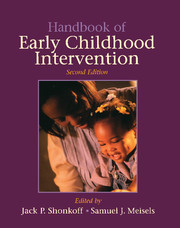Book contents
- Frontmatter
- Contents
- Foreword
- Preface
- Contributors
- PART ONE INTRODUCTION
- PART TWO CONCEPTS OF DEVELOPMENTAL VULNERABILITY AND RESILIENCE
- PART THREE THEORETICAL FRAMEWORKS FOR INTERVENTION
- PART FOUR APPROACHES TO ASSESSMENT
- 11 The Elements of Early Childhood Assessment
- 12 Assessment of Parent–Child Interaction: Implications for Early Intervention
- 13 Family Assessment Within Early Intervention Programs
- 14 Measurement of Community Characteristics
- PART FIVE SERVICE DELIVERY MODELS AND SYSTEMS
- PART SIX MEASURING THE IMPACT OF SERVICE DELIVERY
- PART SEVEN NEW DIRECTIONS FOR THE TWENTY-FIRST CENTURY
- Name Index
- Subject Index
12 - Assessment of Parent–Child Interaction: Implications for Early Intervention
Published online by Cambridge University Press: 05 November 2011
- Frontmatter
- Contents
- Foreword
- Preface
- Contributors
- PART ONE INTRODUCTION
- PART TWO CONCEPTS OF DEVELOPMENTAL VULNERABILITY AND RESILIENCE
- PART THREE THEORETICAL FRAMEWORKS FOR INTERVENTION
- PART FOUR APPROACHES TO ASSESSMENT
- 11 The Elements of Early Childhood Assessment
- 12 Assessment of Parent–Child Interaction: Implications for Early Intervention
- 13 Family Assessment Within Early Intervention Programs
- 14 Measurement of Community Characteristics
- PART FIVE SERVICE DELIVERY MODELS AND SYSTEMS
- PART SIX MEASURING THE IMPACT OF SERVICE DELIVERY
- PART SEVEN NEW DIRECTIONS FOR THE TWENTY-FIRST CENTURY
- Name Index
- Subject Index
Summary
Traditionally, those working with children who have special needs and their parents have focused on helping the child master cognitive, language, and motor goals in which functionally based curricula are used. This approach has centered on the child because of parental concerns about the child's ability to accomplish developmental milestones and because of the emphases of professional training programs on remediating the child's skill deficits. Evaluations of intervention programs demonstrate, however, that focusing on family interactions, as well as on children's skills, may have a greater effect on child development than focusing solely on the child (e.g., Brofenbrenner, 1975; Shonkoff, Hauser-Cram, Krauss, & Upshur, 1992). As a result, the importance of encouraging reciprocal and motivating parent–child interaction is now increasingly recognized (e.g., Bernstein, Hans, & Percansky, 1991; Glovinsky, 1993; Greenspan, 1988; Kelly & Barnard, 1990; McCollum & Hemmeter, 1997; McLean & McCormick, 1993; Thorp & McCollom, 1994).
Previous research has shown that the quality of the early parent–child relationship has important consequences for a child's development (e.g., Bakeman & Brown, 1980; Beckwith & Rodning, 1996; Bee et al. 1982; Belsky, Goode, & Most, 1980; Brazelton, 1988; Coates & Lewis, 1984; Farran & Ramey, 1980; Hann, Osofsky, & Culp, 1996; Kelly, Morisset, Barnard, Hammond, & Booth, 1996; Papousek & Bornstein, 1992; Redding, Harmon, & Morgan, 1990; Tamis-LeMonda & Bornstein, 1989, Wachs & Gruen, 1982).
- Type
- Chapter
- Information
- Handbook of Early Childhood Intervention , pp. 258 - 289Publisher: Cambridge University PressPrint publication year: 2000
- 56
- Cited by

